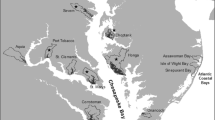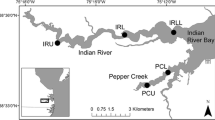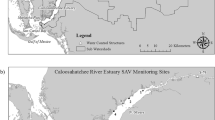Abstract
Shoreline armoring is an ancient and globally used engineering strategy to prevent shoreline erosion along marine, estuarine, and freshwater coastlines. Armoring alters the land water interface and has the potential to affect nearshore submerged aquatic vegetation (SAV) by changing nearshore hydrology, morphology, water clarity, and sediment composition. We quantified the relationships between the condition (bulkhead, riprap, or natural) of individual shoreline segments and three measures of directly adjacent SAV (the area of potential SAV habitat, the area occupied by SAV, and the proportion of potential habitat area that was occupied) in the Chesapeake Bay and nearby Atlantic coastal bays. Bulkhead had negative relationships with SAV in the polyhaline and mesohaline zones. Salinity and watershed land cover significantly modified the effect of shoreline armoring on nearshore SAV beds, and the effects of armoring were strongest in polyhaline subestuaries with forested watersheds. In high salinity systems, distance from shore modified the relationship between shoreline and SAV. The negative relationship between bulkhead and SAV was greater further off shore. By using individual shoreline segments as the study units, our analysis separated the effects of armoring and land cover, which were confounded in previous analyses that quantified average armoring and SAV abundance for much larger study units (subestuaries). Our findings suggest that redesigning or removing shoreline armoring structures may benefit nearshore SAV in some settings. Because armoring is ubiquitous, such information can inform efforts to reverse the global decline in SAV and the loss of the ecosystem services that SAV provides.




Similar content being viewed by others
References
Allord, G.J. 1992. 1 to 2,000,000 hydrologic unit map of the conterminous United States (digital data set). Reston: USGS.
Anderson, D.M., P.M. Glibert, and J.M. Burkholder. 2002. Harmful algal blooms and eutrophication: nutrient sources, composition, and consequences. Estuaries 25: 704–726.
Backman, T.W., and D.C. Barilotti. 1976. Irradiance reduction effects on standing crops of the eelgrass Zostera marina in a coastal lagoon. Marine Biology 34: 33–40.
Baker, M.E., D.E. Weller, and T.E. Jordan. 2006. Comparison of automated watershed delineations: effects on land cover areas, percentages, and relationships to nutrient discharge. Photogrammetric Engineering and Remote Sensing 72: 159–168.
Balouskus, R.G., and T.E. Targett. 2012. Egg deposition by Atlantic silverside, Menidia menidia: substrate utilization and comparison of natural and altered shoreline type. Estuaries and Coasts 35: 1100–1109.
Batiuk, R., P. Bergstrom, et al. 2000. Chesapeake Bay submerged aquatic vegetation water quality and habitat based requirements and restoration targets: a second technical synthesis, 1–231. Annapolis: Chesapeake Bay Program, EPA.
Blake, R.E., J.E. Duffy, and J.P. Richardson. 2014. Patterns of seagrass community response to local shoreline development. Estuaries and Coasts. doi:10.1007/s12237-014-9784-7.
Bourn, W.S. 1932. Ecological and physiological studies on certain aquatic angiosperms. Contributions from Boyce Thompson Institute 4: 425–496.
Brush, G.S., and W.B. Hilgartner. 2000. Paleoecology of submerged macrophytes in the upper Chesapeake Bay. Ecological Monographs 70: 645–667.
Bulleri, F., and M.G. Chapman. 2010. The introduction of coastal infrastructure as a driver of change in marine environments. Journal of Applied Ecology 47: 26–35.
Chesapeake Bay Program. 2004. Chesapeake Bay Program analytical segmentation scheme. Annapolis: Chesapeake Bay Program.
Congdon, R.A., and A.J. McComb. 1979. Productivity of Ruppia: seasonal changes and dependence on light in an Australian estuary. Aquatic Botany 6: 121–132.
Currin, C.A., P.C. Delano, and L.M. Valdes-Weaver. 2007. Utilization of a citizen monitoring protocol to assess the structure and function of natural and stabilized fringing salt marshes in North Carolina. Wetland Ecology and Management 16: 97–118.
Currin, CA, Chappell, WS, and Deaton, A. 2010. Developing alternative shoreline armoring strategies: the living shoreline approach in North Carolina. In Shipman, H, Dethier, MN, Gelfenbaum, G, Fresh, KL, and Dinicola, RS, eds., 2010, Puget Sound Shorelines and the Impacts of Armoring—Proceedings of a State of the Science Workshop, May 2009: U.S. Geological Survey Scientific Investigations Report 2010–5254, p. 91–102.
Curtis, K.J., and A. Schneider. 2011. Understanding the demographic implications of climate change: estimates of localized population predictions under future scenarios of sea-level rise. Population and Environment 33(1): 28–54.
Dan, A., A. Moriguchi, K. Mitsuhashi, and T. Terawaki. 1998. Relationship between Zostera marina beds and bottom sediments, wave action offshore in Naruto, southern Japan (original title: Naruto chisaki ni okeru amamo-ba to teishitsu oyobi haro tono kankei). Fisheries Engineering 34: 299–304.
derHeide, T.V., E.H. van Nes, G.W. Geerling, A.J.P. Smolders, T.J. Bouma, and M.M. Van Katwijk. 2007. Positive feedbacks in seagrass ecosystems: implications for success in conservation and restoration. Ecosystems 10: 1311–1322.
Dugan, J.E., D.M. Hubbard, I.F. Rodil, D.L. Revell, and S. Schoeter. 2008. Ecological effects of coastal armoring on sandy beaches. Marine Ecology 29: 160–170.
EEA. 2006. The changing faces of Europe’s coastal areas (EEA Report 6/2006). Luxembourg: OPOCE. retrieved from: http://www.eea.europa.eu/publications/eca-report-2006-6.
ESRI. 2011. ArcGIS Desktop: Release 9.3. Redlands: Environmental Systems Research Institute.
Findlay, S., W.C. Nieder, and D.T. Fischer. 2006. Multi-scale controls on water quality effects of submerged aquatic vegetation in the tidal freshwater Hudson River. Ecosystems 9: 84–96.
Findlay, S.E.G., D.L. Strayer, S.D. Smith, and N. Curri. 2014. Magnitude and patterns of change in submerged aquatic vegetation in the tidal freshwater Hudson River. Estuaries and Coasts. doi:10.1007/s12237-013-9758-1.
Gabriel, A.O., and L.R. Bodensteiner. 2012. Impacts of riprap on wetland shorelines, Upper Winnebago Pool Lakes, Wisconsin. Wetlands 32: 105–117.
Gallegos, C.L. 2001. Calculating optical water quality targets to restore and protect submersed aquatic vegetation: overcoming problems in partitioning the diffuse attenuation coefficient for photosynthetically active radiation. Estuaries 24: 381–397.
Gallegos, C.L., and P. Bergstrom. 2005. Effects of a Prorocentrum minimum bloom on light availability for and potential impacts on submersed aquatic vegetation in upper Chesapeake Bay. Harmful Algae 4: 553–574.
Gallegos, C.L., P.J. Werdell, and C.R. McClain. 2011. Long-term changes in light scattering in Chesapeake Bay inferred from Secchi depth, light attenuation, and remote sensing measurements. Journal of Geophysical Research 116(C7): 1–19.
Goldsborough, W.J., and W.M. Kemp. 1988. Light responses of a submersed macrophyte: implications for survival in turbid tidal waters. Ecology 69: 1775–1786.
Gruber, R.K., D.C. Hinkle, and W.M. Kemp. 2011. Spatial patterns in water quality associated with submersed plant beds. Estuaries and Coasts 34: 961–972.
Hale, S.S., J.F. Paul, and J.F. Heltshe. 2004. Watershed landscape indicators of estuarine benthic condition. Estuaries 27: 283–295.
Heck Jr., K.L., and C.M. Duarte. 2000. Critical evaluation of the nursery role hypothesis for seagrass meadows. Marine Ecology Progress Series 253: 123–136.
Heck Jr., K.L., and T.A. Thoman. 1984. The nursery role of seagrass meadows in the upper and lower reaches of the Chesapeake Bay. Estuaries 7: 70–92.
Hemminga, M., and C.M. Duarte. 2000. Seagrass ecology. Cambridge: Cambridge University Press.
Homer, C., C. Huang, L. Yang, B. Wylie, and M. Coan. 2004. Development of a 2001 National Land-Cover Database for the United States. Photogrammatic Engineering and Remote Sensing 70: 829–840.
Kemp, W.M., R. Batiuk, R. Bartleson, P. Bergstrom, V. Carter, C.L. Gallegos, W. Hunley, L. Karrh, E.W. Koch, J.M. Landwehr, K.A. Moore, L. Murray, M. Naylor, N.B. Rybicki, J.C. Stevenson, and D.J. Wilcox. 2004. Habitat requirements for submerged aquatic vegetation in Chesapeake Bay: water quality, light regime, and physical-chemical factors. Estuaries 27: 363–377.
Kimber, A., J.L. Owens, and W.G. Crumpton. 1995. Light availability and growth of wild celery (Vallisneria americana) in upper Mississippi River backwaters. Regulated Rivers: Research and Management 11: 167–174.
King, R.S., A.H. Hines, F.D. Craige, and S. Grap. 2005. Regional, watershed, and local correlates of blue crab and bivalve abundances in subestuaries of Chesapeake Bay, USA. Journal of Experimental Marine Biology and Ecology 319: 101–116.
Li, X., D.E. Weller, C.L. Gallegos, T.E. Jordan, and H.C. Kim. 2007. Effects of watershed and estuarine characteristics on the abundance of submerged aquatic vegetation in Chesapeake Bay subestuaries. Estuaries and Coasts 30: 840–854.
Living Shoreline Summit Steering Committee 2006. Preface. Proceedings of the 2006 Living Shoreline Summit, Chesapeake Bay, CRC Publ. No. 08–164.
Lubbers, L., W.R. Boynton, and W.M. Kemp. 1990. Variations in structure of estuarine fish communities in relation to abundance of submersed vascular plants. Marine Ecology Progress Series 65: 1–14.
Marba, N.N., J. Cebrian, S. Enriquez, and C.M. Duarte. 1994. Migration of large-scale subaqueous bedforms measured with seagrasses (Cymodocea nodosa) as tracers. Limnology and Oceanography 39: 126–133.
Miles, J.R., P.E. Russell, and D.A. Huntley. 2001. Field measurement of sediment dynamics in front of a seawall. Journal of Coastal Research 17: 195–206.
Mills, K.E., and M.S. Fonseca. 2003. Mortality and productivity of eelgrass Zostera marina under conditions of experimental burial with two sediment types. Marine Ecology Progress Series 255: 127–134.
Moore, K.A., and J.C. Jarvis. 2008. Environmental factors affecting recent summertime eelgrass diebacks in the lower Chesapeake Bay: implications for long-term persistence. Journal of Coastal Research 55: 135–147.
Moore, K.A., D.J. Wilcox, and R.J. Orth. 2000. Analysis of the abundance of submersed aquatic vegetation communities in the Chesapeake Bay. Estuaries 23: 115–127.
Morley, S.A., J.D. Toft, and K.M. Hanson. 2012. Ecological effects of shoreline armoring on intertidal habitats of a Puget Sound urban estuary. Estuaries and Coasts 35: 774–784.
NOAA (National Oceanic and Atmospheric Administration). 2006. U.S. Bathymetric and Fishing Maps. National Ocean Service Office of Coast Survey, NOAA National Geophysical Data Center. http://www.ngdc.noaa.gov/mgg/bathymetry/maps/. Accessed 11 Apr 2014.
NOAA (National Oceanic and Atmospheric Administration). 2011. US Coastal Relief Model—Southeast Atlantic. NOAA National Geophysical Data Center. http://www.ngdc.noaa.gov/mgg/coastal/grddas02/grddas02.htm. Accessed 11 Apr 2014.
Orth, R.J., and K.A. Moore. 1984. Distribution and abundance of submerged aquatic vegetation in Chesapeake Bay: an historical perspective. Estuaries 7: 531–540.
Orth, R.J., R.A. Batiuk, P. Bergstrom, and K.A. Moore. 2002. A perspective on two decades of policies and regulations influencing the protection and restoration of submerged aquatic vegetation in Chesapeake Bay, USA. Bulletin of Marine Sciences 71: 1391–1403.
Orth, R.J., T.J.B. Carruthers, W.C. Dennison, C.M. Duarte, J.W. Fourqurean, K.L. Heck Jr., A.R. Hughes, G.A. Kendrick, W.J. Kenworthy, S. Olyarnik, F.T. Short, M. Waycott, and S.L. Williams. 2006. A global crisis for seagrass ecosystems. Bioscience 56: 987–996.
Orth, R.J., S.R. Marion, K.A. Moore, and D.J. Wilcox. 2010a. Eelgrass (Zostera marina L.) in the Chesapeake Bay Region of mid-Atlantic coast of the USA: challenges in conservation and restoration. Estuaries and Coasts 33: 139–150.
Paling, E.I., M. van Keulen, and K.D. Wheeler. 2003. The influence of spacing on mechanically transplanted seagrass survival in a high energy regime. Restoration Ecology 11: 56–61.
Patrick, C.J., D. Weller, M. Ryder, and L. Xuyong. 2014. Effect of watershed land use and shoreline alteration on submerged aquatic vegetation in the Chesapeake Bay at the scale of the subestuary. Estuaries and Coasts. doi:10.1007/s122237-014-9768-7.
Pope, J. 1997. Responding to coastal erosion and flooding damages. Journal of Coastal Research 13(3): 704–710.
Posey, M.H., C. Wigan, and J.C. Stevenson. 1993. Effects of an introduced aquatic plant, Hydrilla verticillata, on benthic communities in the upper Chesapeake Bay. Estuarine, Coastal and Shelf Science 37: 539–555.
R Development Core Team. 2012. R: a language and environment for statistical computing. R Foundation for Statistical Computing, Vienna, Austria. http://www.R-project.org/.
Rice, C.A. 2006. Effects of shoreline modification on a Northern Puget Sound beach: microclimate and embryo mortality in surf smelt. Estuaries and Coasts 29: 63–71.
Rosen, P.S., and D.B. Vine. 1995. Evolution of seawall construction methods in Boston Harbor, Massachusetts. Proceedings of the Institution of Civil Engineers Structures and Buildings 110: 239–249.
Seitz, R.D., R.N. Lipicius, N.H. Olmstead, M.S. Seebo, and D.M. Lambert. 2006. Influence of shallow-water habitats and shoreline development upon abundance, biomass, and diversity of benthic prey and predators in Chesapeake Bay. Marine Ecology Progress Series 326: 11–27.
Short, F.T., D.M. Burdick, and J.E. Kaldy III. 1995. Mesocosm experiments quantify the effects of eutrophication on eelgrass, Zostera marina. Limnology and Oceanography 40: 740–749.
Small, C., and R.J. Nicholls. 2003. A global analysis of human settlement in coastal zones. Journal of Coastal Research 19(3): 584–599.
Stevenson, J.C., L.W. Staver, and K.W. Staver. 1993. Water quality associated with survival of submersed aquatic vegetation along an estuarine gradient. Estuaries 16: 346–361.
Steward, K.K. 1991. Light requirements for growth of monoecious hydrilla from the Potomac River. Florida Scientist 54: 204–214.
Strayer, D.L., and S. Findlay. 2010. Ecology of freshwater shore zones. Aquatic Sciences 72: 127–163.
USEPA (U.S. Environmental Protection Agency). 2003. Technical support document for the identification of Chesapeake Bay designated uses and attainability EPA 903-R-03-004. Annapolis: U.S. EPA Chesapeake Bay Program.
USGS (U.S. Geological Survey). 2006. Hydrologic unit maps. http://water.usgs.gov/GIS/huc.html. Accessed 11 Apr 2014.
VIMS (Virginia Institute of Marine Sciences). 2013a. GIS data & maps: shoreline inventories. Center for Coastal Resources Management. http://ccrm.vims.edu/gis_data_maps/shoreline_inventories/index.html. Accessed 11 Apr 2014.
VIMS (Virginia Institute of Marine Sciences). 2013b. Submerged aquatic vegetation (SAV) in Chesapeake Bay and Delmarva Peninsula coastal bays. http://web.vims.edu/bio/sav/index.html. Accessed 11 Apr 2014.
Wigand, C., M. Finn, S. Findlay, and D. Fischer. 2001. Submersed macrophyte effects on nutrient exchanges in riverine sediments. Estuaries 24: 398–406.
Wright, L.D. 1995. Morphodynamics of inner continental shelves. Boca Raton: CRC.
Acknowledgments
We thank the Virginia Institute of Marine Sciences, the Maryland Department of Natural Resources, and the Chesapeake Bay Program for providing data used in our analysis. This work was supported by award number NA09NOS4780214 from the National Oceanic and Atmospheric Administration (NOAA) Center for Sponsored Coastal Ocean Research (CSCOR).
Author information
Authors and Affiliations
Corresponding author
Additional information
Communicated by Patricia Wiberg
Rights and permissions
About this article
Cite this article
Patrick, C.J., Weller, D.E. & Ryder, M. The Relationship Between Shoreline Armoring and Adjacent Submerged Aquatic Vegetation in Chesapeake Bay and Nearby Atlantic Coastal Bays. Estuaries and Coasts 39, 158–170 (2016). https://doi.org/10.1007/s12237-015-9970-2
Received:
Revised:
Accepted:
Published:
Issue Date:
DOI: https://doi.org/10.1007/s12237-015-9970-2




